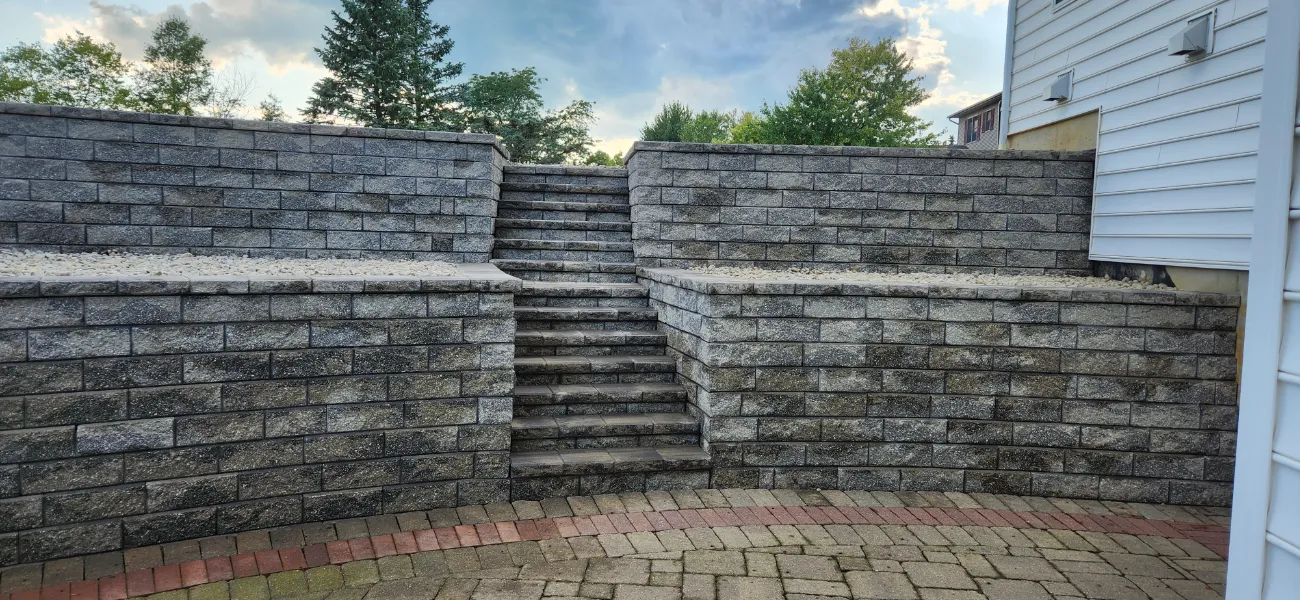Is Your Retaining Wall Failing? Signs to Look for and What to Do Next
A failing retaining wall can lead to significant problems, from soil erosion to potential property damage. Whether you have an old landscape tie wall that's rotting or a block retaining wall that wasn't installed properly, it's important to address the issue quickly before it worsens.
In this guide, we’ll cover the key signs of retaining wall failure, explain why a repair is often not an option, and walk you through the steps to take for a lasting solution.
Common Signs of Retaining Wall Failure
Retaining walls are designed to hold back soil and prevent erosion, but over time, poor construction, inadequate materials, or natural elements can cause them to fail. Here are the most common signs that indicate your retaining wall is in trouble:
1. Bulging or Bowing Retaining Wall
When a retaining wall starts to bulge or bow outward, it’s a clear sign that it’s losing its structural integrity. This usually happens when the wall can’t handle the lateral pressure from the soil behind it, often due to poor drainage or insufficient reinforcement, we will talk about both in this article.
2. Cracking or Shifting Blocks
Cracks in the blocks or between the layers of the wall are another indication of failure. These cracks may start small, but over time they can widen and cause the wall to shift. Hydrostatic pressure (water buildup behind the wall) often contributes to this issue.
3. Leaning or Collapsing Retaining Wall
A wall that is leaning significantly or showing signs of collapsing needs immediate attention. Leaning often occurs when the base of the wall was not properly prepared or when soil movement, such as from wall surcharges (additional weight behind the wall), wasn’t accounted for.
4. Rotting Landscape Ties
For those with older landscape tie retaining walls, rotting wood is a common problem. As these ties degrade, they lose the ability to retain the soil, causing the wall to buckle or fall apart entirely.
Why Repairing a Failed Retaining Wall Isn’t an Option
While it may be tempting to seek a quick fix for a failing retaining wall, the reality is that once a wall starts to give way, it’s unlikely that a repair will solve the problem long-term. In fact, be wary of any contractor who suggests a patch job or repair. Here's why:
Underlying Issues Remain: The root cause of the failure—whether it’s poor drainage, lack of reinforcement, or a faulty base—won’t be resolved with a surface-level repair.
Structural Integrity is Compromised: A compromised wall, especially one showing signs of bulging or cracking, cannot regain its original strength without a full replacement.
Safety Concerns: A failing wall can pose serious risks to your property and safety. Collapsing retaining walls can damage nearby structures, landscapes, or hardscapes.
The best course of action is to tear down the existing wall and excavate the area to prepare for a proper installation. This ensures the underlying issues are addressed, and the new wall is designed to stand the test of time.
How a Proper Retaining Wall is Built: Key Engineering Considerations
A well-built retaining wall must be able to withstand the forces pushing against it, including hydrostatic pressure from water buildup and wall surcharges from structures or heavy soil above the wall. Here’s a closer look at how a proper retaining wall is engineered:
1. Geo-Grid Reinforcement
For taller walls or walls retaining a significant amount of soil, geo-grid is essential. Geo-grid is a geosynthetic material that reinforces the soil behind the wall, helping to stabilize the structure by distributing the weight and pressure more evenly. The grid is placed between the layers of blocks and extends back into the soil, creating a stronger wall system.
2. Addressing Hydrostatic Pressure
One of the leading causes of retaining wall failure is the buildup of hydrostatic pressure—water that accumulates behind the wall and adds weight to the soil. A proper retaining wall installation must include drainage solutions such as weep holes, drainage pipes, or a gravel backfill to allow water to escape and reduce pressure.
3. Wall Surcharges and Load Considerations
When a retaining wall is built on a slope or below structures like driveways, patios, or buildings, the added weight is known as a surcharge. This additional pressure must be factored into the wall’s design, often requiring stronger reinforcement, a thicker base, or a more significant setback for stability.
4. Solid Base and Proper Setback
The foundation of the wall is just as important as the wall itself. A compacted gravel base is essential for preventing the wall from sinking or shifting over time. Additionally, block retaining walls should have a slight setback (tilt backward) to help resist the lateral pressure from the soil.
Proper Retaining Wall Installation Using Unilock and Oberfields Products
At Double A Services, we use high-quality hardscape products from Unilock and Oberfields, both of which are known for their durability and aesthetic appeal. Here's a glimpse of the installation process when using these products for retaining walls:
1. Excavation and Base Preparation
The first step is excavating the area to ensure there is room for a 6-8 inch gravel base. This base is compacted to create a solid foundation that prevents settling and shifting.
2. Layering and Geo-Grid Installation
Once the base is prepared, we begin laying the first course of Unilock or Oberfields blocks. We take the time to ensure the first course is set into the base correctly and level. For taller walls, geo-grid is installed between layers of blocks to reinforce the wall and stabilize the soil behind it. This ensures that the wall can withstand the weight of the soil and any surcharges.
3. Proper Drainage Installation
Drainage pipes are installed behind the wall to allow water to flow out from behind the wall, reducing hydrostatic pressure. Additionally, a layer of gravel backfill is placed behind the wall to help with water filtration.
4. Final Layering and Capstones
After all layers are in place, we add the final course of blocks and install capstones for a finished look. These caps are often glued in place to ensure durability and prevent shifting.
Avoid the Low Bid: Why Quality Matters in Retaining Wall Construction
While it might be tempting to go with the lowest bid, this is rarely the best option when it comes to retaining walls. Proper retaining wall construction requires careful planning, high-quality materials, and attention to detail. Here’s why you should avoid going for the lowest bidder:
Poor Drainage Solutions: Inadequate drainage is one of the main causes of retaining wall failure, and cheaper contractors may cut corners in this area.
Subpar Materials: Using lower-grade materials can compromise the durability and strength of your wall.
Lack of Engineering: Without proper consideration for geo-grid reinforcement or surcharge loads, a poorly built wall will fail under pressure.
A well-built retaining wall, especially one using Unilock or Oberfields products, should last for decades with minimal maintenance. Always choose a contractor with experience and expertise in proper retaining wall construction to ensure your wall stands the test of time.
We Replace Retaining Walls in the Following Areas in Central Ohio
At Double A Services, we specialize in retaining wall replacement and serve homeowners in the following areas:
Contact Us Today to Replace Your Retaining Wall
If your retaining wall is failing, don’t wait until it causes further damage. At Double A Services, we offer expert retaining wall replacement using high-quality Unilock and Oberfields products. Our team will design and install a durable retaining wall that enhances your property and lasts for years to come.
Contact us today to schedule a consultation and get a free estimate on your retaining wall replacement project. Let us help you protect your landscape with a wall that’s built to last!
Call (614) 537-6088 or fill out our online estimate to request a consultation for your failing retaining wall and an estimate to replace it properly!







